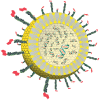An ultra-sensitive immunoassay for quantifying biomarkers in breast tumor tissue
- PMID: 24494029
- PMCID: PMC3909766
- DOI: 10.7150/jca.8084
An ultra-sensitive immunoassay for quantifying biomarkers in breast tumor tissue
Abstract
Urokinase-type plasminogen activator (uPA) and plasminogen activator inhibitor type-1 (PAI-1) have been validated at the highest level of evidence as clinical biomarkers of prognosis in breast cancer. The American Society of Clinical Oncology recommends using uPA and PAI-1 levels in breast tumors for deciding whether patients with newly diagnosed node-negative breast cancer can forgo adjuvant chemotherapy. The sole validated method for quantifying uPA and PAI-1 levels in breast tumor tissue is a colorimetric ELISA assay that takes 3 days to complete and requires 100-300 mg of fresh or frozen tissue. In this study we describe a new assay method for quantifying PAI-1 levels in human breast tumor tissue. This assay combines pressure-cycling technology to extract PAI-1 from breast tumor tissue with a highly sensitive liposome polymerase chain reaction immunoassay for quantification of PAI-1 in the tissue extract. The new PAI-1 assay method reduced the total assay time to one day and improved assay sensitivity and dynamic range by >100, compared to ELISA.
Keywords: breast cancer; high-pressure tissue extraction; immunoassay; immunoliposome-PCR; plasminogen activator inhibitor type-1; tissue biomarkers.
Conflict of interest statement
Competing Interests: Carol B. Fowler and Jeffrey T. Mason are named as lead contributors on two patents (USPTO numbers: 20130011854 and 20100136613) entitled “Pressure-Assisted Antigen Retrieval (PAAR), Pressure-Assisted Molecule Recovery (PAMR), and Pressure-Assisted Tissue Histology (PATH)”. Jeffrey T. Mason is named as a lead contributor on two patents (USPTO numbers: 20090176250 and 20050158372) entitled “Immunoliposome-Nucleic Acid Amplification (ILNAA) Assay”. The assignee on all four patents is the United States of America as represented by the Secretary of the Army and/or the Secretary of Veterans Affairs.
Figures



Similar articles
-
Quantitative RT-PCR assays for the determination of urokinase-type plasminogen activator and plasminogen activator inhibitor type 1 mRNA in primary tumor tissue of breast cancer patients: comparison to antigen quantification by ELISA.Int J Mol Med. 2008 Feb;21(2):251-9. Int J Mol Med. 2008. PMID: 18204793
-
Ten-year analysis of the prospective multicentre Chemo-N0 trial validates American Society of Clinical Oncology (ASCO)-recommended biomarkers uPA and PAI-1 for therapy decision making in node-negative breast cancer patients.Eur J Cancer. 2013 May;49(8):1825-35. doi: 10.1016/j.ejca.2013.01.007. Epub 2013 Mar 13. Eur J Cancer. 2013. PMID: 23490655 Clinical Trial.
-
Randomized adjuvant chemotherapy trial in high-risk, lymph node-negative breast cancer patients identified by urokinase-type plasminogen activator and plasminogen activator inhibitor type 1.J Natl Cancer Inst. 2001 Jun 20;93(12):913-20. doi: 10.1093/jnci/93.12.913. J Natl Cancer Inst. 2001. PMID: 11416112 Clinical Trial.
-
Urokinase-type plasminogen activator and its inhibitor type 1 predict disease outcome and therapy response in primary breast cancer.Clin Breast Cancer. 2004 Dec;5(5):348-52. doi: 10.3816/cbc.2004.n.040. Clin Breast Cancer. 2004. PMID: 15585071 Review.
-
Urokinase-type plasminogen activator (uPA) and its inhibitor PAI-I: novel tumor-derived factors with a high prognostic and predictive impact in breast cancer.Thromb Haemost. 2004 Mar;91(3):450-6. doi: 10.1160/TH03-12-0798. Thromb Haemost. 2004. PMID: 14983219 Review.
Cited by
-
Improving the Proteomic Analysis of Archival Tissue by Using Pressure-Assisted Protein Extraction: A Mechanistic Approach.J Proteomics Bioinform. 2014 Jun 24;7(6):151-157. doi: 10.4172/jpb.1000315. J Proteomics Bioinform. 2014. PMID: 25049470 Free PMC article.
-
Design Strategies for Electrochemical Aptasensors for Cancer Diagnostic Devices.Sensors (Basel). 2021 Jan 22;21(3):736. doi: 10.3390/s21030736. Sensors (Basel). 2021. PMID: 33499136 Free PMC article. Review.
References
-
- Ulisse S, Baldini E, Sorrenti S. et al. The urokinase plasminogen activator system: a target for anti-cancer therapy. Curr Cancer Drug Targets. 2009;9:32–71. - PubMed
-
- Harbeck N, Thomssen C. A new look at node-negative breast cancer. The Oncologist. 2010;15:29–38. - PubMed
-
- Harbeck N, Schmitt M, Meisner C. et al. Ten-year analysis of the prospective multicenter Chem-N0 trial validates American Society of Clinical Oncology (ASCO)-recommended biomarkers uPA and PAI-1 for therapy decision making in node-negative breast cancer patients. Eur J Cancer. 2013;49:1825–1835. - PubMed
-
- Jänicke F, Prechtl A, Thomssen C. et al. Randomized adjuvant chemotherapy trial in high-risk lymph node-negative breast cancer patients identified by urokinase-type plasminogen activator and plasminogen activator inhibitor type 1. J Natl Cancer Inst. 2001;93:913–920. - PubMed
-
- Blasi F. Proteolysis, cell adhesion, chemotaxis, and invasiveness are regulated by the u-PA-u-PAR-PAI-1 system. Thromb Haemost. 1999;82:298–304. - PubMed
Grants and funding
LinkOut - more resources
Full Text Sources
Other Literature Sources
Miscellaneous

